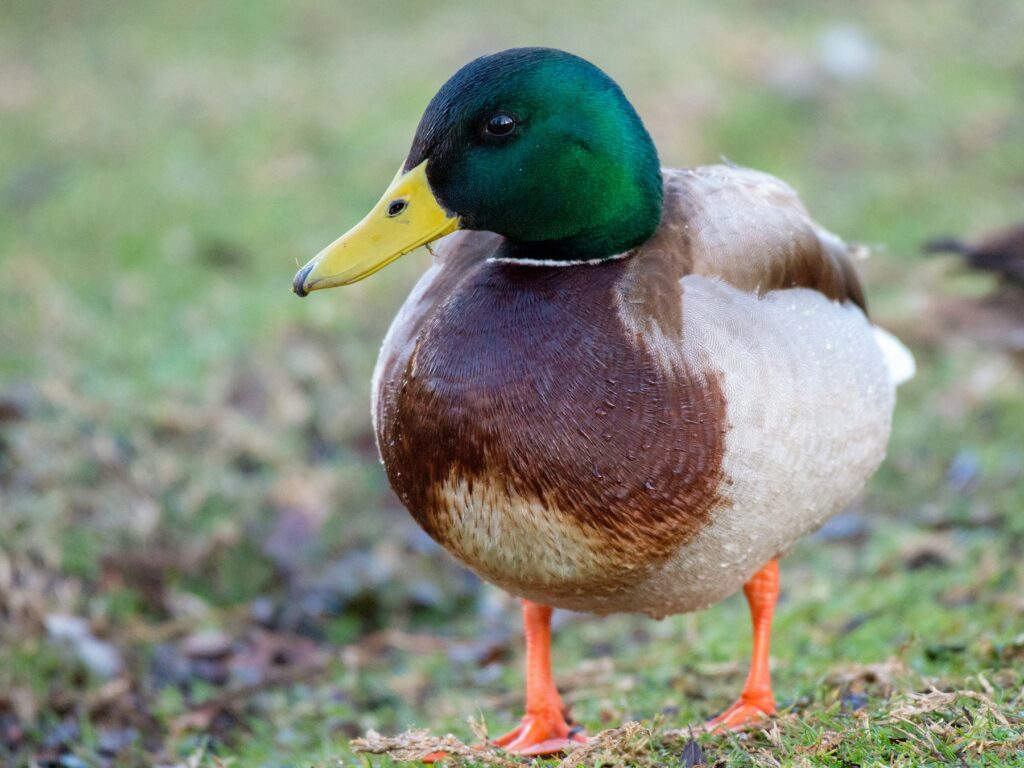Mallards, scientifically known as Anas platyrhynchos, are one of the most recognised and widespread species of ducks in the world. These colourful waterfowl can be found in various habitats across the United Kingdom. With their distinctive appearance, remarkable adaptability, and intriguing behaviours, mallards have captivated the attention of bird enthusiasts and nature lovers alike. In this article, we will explore the fascinating world of mallards, delving into their physical characteristics, habitat preferences, feeding habits, breeding behaviour, and conservation status in the United Kingdom.
Physical Characteristics
Mallards are medium-sized ducks with a length ranging from 50 to 65 centimetres (20 to 26 inches) and a wingspan of approximately 81 to 98 centimetres (32 to 39 inches). The male mallard, also known as a drake, exhibits a vibrant plumage with a glossy green head, a white neck ring, and a chestnut-brown breast. Its wings are bluish-grey, and the back and sides are a mottled brown. In contrast, female mallards, referred to as hens, possess more muted colours. They feature a mottled brown body with an orange-and-brown bill.
Mallards also have unique physical adaptations that enable them to thrive in different environments. Their webbed feet are perfectly designed for swimming and navigating through aquatic vegetation. The speculum, a patch of iridescent blue feathers on the wings, is another distinctive feature of mallards. This striking colouration is most visible during flight and serves as a visual signal during courtship displays.

Habitat and Distribution
Mallards are highly adaptable and can be found in a wide range of aquatic habitats across the United Kingdom, including lakes, ponds, rivers, marshes, and coastal areas. They are one of the most common duck species in the country. Mallards are versatile in their habitat preferences and can be found in both urban and rural environments. They often frequent parks, gardens, and even city centre ponds.
During the breeding season, mallards prefer nesting near water bodies with dense vegetation, providing cover for their nests and young ducklings. In the United Kingdom, mallards can be observed nesting in a variety of locations, including reed beds, wetlands, and even garden ponds. Their adaptability to different environments contributes to their widespread presence in the country.

Feeding Habits
Mallards are omnivorous, feeding on a diverse diet that includes aquatic plants, seeds, grains, insects, crustaceans, and small fish. They are opportunistic feeders and can adapt their diet based on seasonal availability. Mallards often dabble on the water’s surface, upending their bodies to reach underwater vegetation or small invertebrates. They also graze on land, particularly during the non-breeding season when they venture into fields and agricultural areas in search of grains and seeds.
Their ability to exploit various food sources contributes to the mallard’s success as a species. Mallards are known to feed on agricultural crops, such as barley and wheat, which can sometimes result in conflicts with farmers. However, these ducks also play a valuable role in controlling insect populations and dispersing seeds as they move between habitats.
Breeding Behavior
Mallards exhibit interesting breeding behaviours that involve courtship displays and nest-building rituals. During the spring breeding season, males engage in elaborate displays, including head bobbing, tail wagging, and low-pitched calls to attract females. Once the pair bond is formed, the female constructs a nest on the ground, usually hidden among vegetation near the water’s edge. She lines the nest with down feathers and lays a clutch of about 8 to 13 eggs. Incubation takes around 26 to 30 days, with the female solely responsible for incubating the eggs.
Once the eggs hatch, the female leads the ducklings to nearby water bodies, where they begin to forage and learn essential survival skills. Mallards are precocial, meaning their young are relatively independent and able to swim and feed shortly after hatching. However, the female remains vigilant, providing protection and guidance until the ducklings can fend for themselves.
Conservation Status
Mallards are considered a species of least concern in terms of conservation status. Their adaptability to different habitats and widespread distribution contribute to their relatively secure status. However, various factors, such as habitat loss, pollution, hunting, and interbreeding with domestic ducks, can impact local mallard populations.
Wetland conservation plays a crucial role in ensuring the long-term survival of mallards and other waterfowl species in the UK. Preserving and restoring wetland habitats provides essential nesting sites, foraging areas, and shelter for mallards during their annual lifecycle. Additionally, responsible hunting practices and regulations help maintain sustainable mallard populations and support wetland conservation efforts.
Conclusion
The mallard duck, with its striking colours, adaptability, and intriguing behaviours, remains an iconic species of waterfowl in the United Kingdom. From their vibrant plumage to their courtship displays and successful breeding strategies, mallards captivate the imagination of bird enthusiasts. Despite facing various challenges, their widespread distribution and ability to adapt make them a species of least concern in the country. By understanding and appreciating these remarkable ducks, we can work towards preserving their habitats and ensuring their continued presence in the United Kingdom’s natural landscapes.
Additional Resources
Sam loves to learn about animals and their habitats. He has been a nature lover from a very young age, and has been writing papers and articles about wildlife for as long as he can remember.
